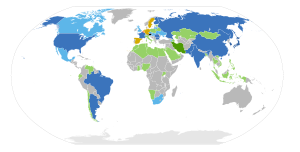- Nuclear power in Canada
-
Electricity generation in Canada Hydroelectric
Nuclear
Coal
Natural gas
Wind
SolarNuclear power in Canada produces about 15% of Canada's electricity as of 2009.[1]
Contents
History
The nuclear industry (as distinct from the uranium industry) in Canada dates back to 1942 when a joint British-Canadian laboratory, the Montreal Laboratory, was set up in Montreal, Quebec, under the administration of the National Research Council of Canada, to develop a design for a heavy-water nuclear reactor. This reactor was called National Research Experimental and would be the most powerful research reactor in the world when completed. In the meantime, in 1944, approval was given to proceed with the construction of the smaller ZEEP (Zero Energy Experimental Pile) test reactor at Chalk River, Ontario and on September 5, 1945 at 3:45 p.m., the 10 Watt ZEEP successfully achieved the first self-sustained nuclear reaction outside the United States. ZEEP operated for 25 years as a key research facility.[citation needed]
In 1946, the Montreal Laboratory was closed, and the work continued at the Chalk River Nuclear Laboratories. Building partly on the experimental data obtained from ZEEP, the National Research Experimental (NRX)—a natural uranium, heavy water moderated research reactor—started up on July 22, 1947. It operated for 43 years, producing radioisotopes, undertaking fuels and materials development work for CANDU reactors, and providing neutrons for physics experiments. It was eventually joined in 1957 by the larger 200 megawatt (MW) National Research Universal (NRU) reactor.
In 1952, the Canadian government formed AECL, a Crown corporation with the mandate to develop peaceful uses of nuclear energy. A partnership was formed between AECL, Ontario Hydro and Canadian General Electric to build Canada's first nuclear power plant, called NPD for Nuclear Power Demonstration. The 20 MWe NPD started operation in 1962 and successfully demonstrated the unique concepts of on-power refuelling using natural uranium fuel, and heavy water moderator and coolant. These features formed the basis of a fleet of CANDU power reactors (CANDU is an acronym for CANada Deuterium Uranium) built and operated in Canada and elsewhere.
In the late 1960s (1967–1970), Canada also developed an experimental miniature nuclear reactor named SLOWPOKE (acronym for Safe Low-Power Kritical Experiment). The first prototype was built at Chalk River and many SLOWPOKEs were subsequently built, mainly for research. This reactor design is extremely safe and requires almost no maintenance (it is even licensed to operate unattended overnight); it can run for more than 20 years before the nuclear fuel needs replacement.[citation needed] There was an attempt at commercializing the reactor, as it could be used in remote areas or vehicles (research stations, electric-diesel submarines).[citation needed] Then, China entered the market with its SLOWPOKE-like reactor and thus, the project lost its commercial potential.[citation needed] Many SLOWPOKEs are still in use in Canada; there is one running at École Polytechnique de Montréal, for instance.
Proposals
The Province of Ontario has announced plans to build a new nuclear station. The leading candidate is AECL's Advanced CANDU Reactor. Environmental assessments are currently underway for one site next to Bruce Power's Bruce Nuclear Generating Station in Tiverton and another next to Ontario Power Generation's Darlington Nuclear Generating Station. Bruce Power has applied for a license to generate nuclear power at Cardinal Lake, Alberta.[2]
Safety
Following the 2011 Japanese nuclear accidents, the Canadian Nuclear Safety Commission has "ordered all reactor operators to revisit their safety plans and report on potential improvements" by the end of April.[3]
See also
- Electricity sector in Canada
- Nuclear industry in Canada
- List of nuclear reactors
- Canadian Nuclear Association
- Atomic Energy of Canada Limited
- Energy Alberta Corporation
- Pembina Institute
- Anti-nuclear movement in Canada
- Science and technology in Canada
References
- ^ Statistics Canada (April 2009), Electric Power Generation, Transmission and Distribution (catalog number: 57-202-X), Ottawa: Statistics Canada, pp. 10–11, ISSN 1703-2636, http://www.statcan.gc.ca/pub/57-202-x/57-202-x2007000-eng.pdf
- ^ Bruce Power buys assets of Energy Alberta Corp.
- ^ Sarah Boesveld (March 21, 2011). "Nuclear commission orders Canadian reactors to review safety plans". National Post. http://www.nationalpost.com/news/Nuclear+commission+orders+Canadian+reactors+review+safety+plans/4480373/story.html.
Further reading
- Steed, Roger G (2007), Nuclear Power in Canada and Beyond, General Store Pub. House, ISBN 9781897113516, http://books.google.ca/books?id=Eq_3A95k1u8C&lpg=PP1&dq=Nuclear%20power%20in%20Canada&pg=PP1#v=onepage&q&f=false
- Atomic Energy Canada, Limited (1997), Canada enters the nuclear age, McGill-Queen's University Press, ISBN 0773516018, http://books.google.ca/books?id=SkrVDKMconIC&lpg=PA206&dq=Nuclear%20power%20in%20Canada&pg=PP1#v=onepage&q&f=false
External links
- The Canadian Nuclear FAQ
- The Canadian Nuclear Society
- "Entering the Nuclear Age" (Legion Magazine, Sept/Oct 2003)
- "Economic Impact of the Nuclear Industry in Canada" (Canadian Energy Research Institute, 2003)
- "Nuclear Power in Canada: An Examination of Risks, Impacts and Sustainability" (Pembina Institute, 2006)
- "Where is my Electricity Coming From at this Hour? (if I lived in Ontario)" (Canadian Nuclear Society, with data from IESO)
Nuclear power by country GWe > 10 Canada · China · EU (France · Germany · United Kingdom) · Japan · Russia · South Korea · Ukraine · United States
GWe > 2 EU (Belgium · Czech Republic · Finland · Spain · Sweden) · India · Republic of China (Taiwan) · SwitzerlandGWe > 1 GWe < 1 Planned Phasing-out Opposed Categories:- Nuclear energy in Canada
- Nuclear power by country
Wikimedia Foundation. 2010.
